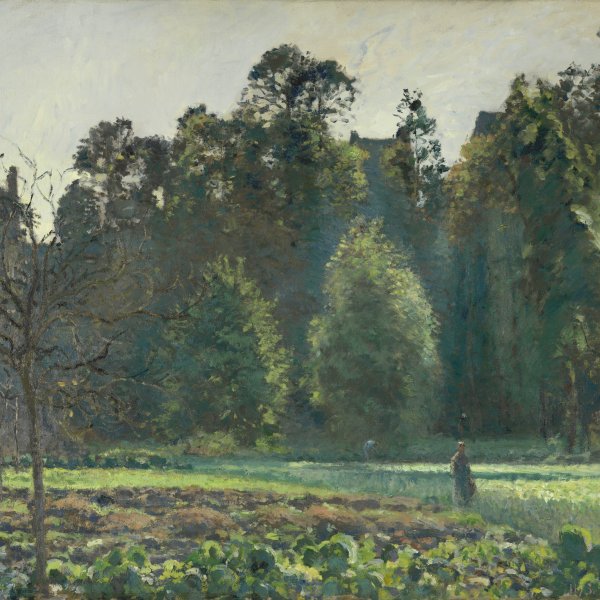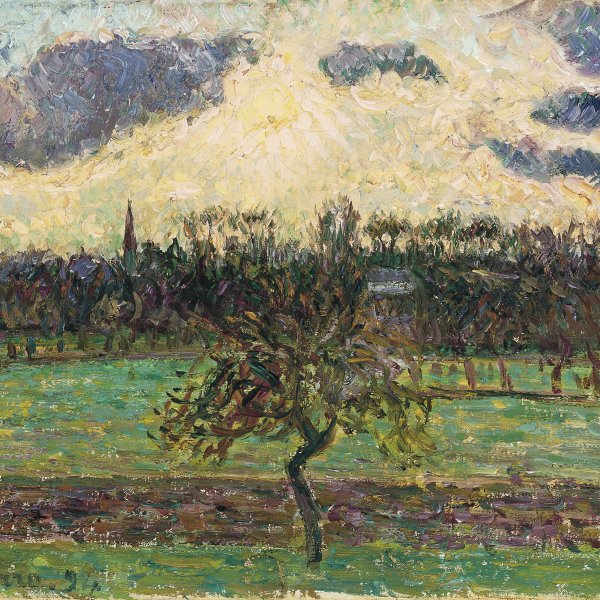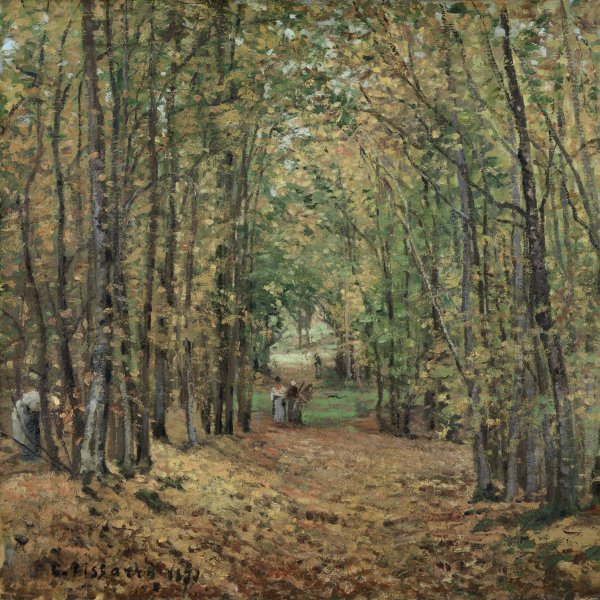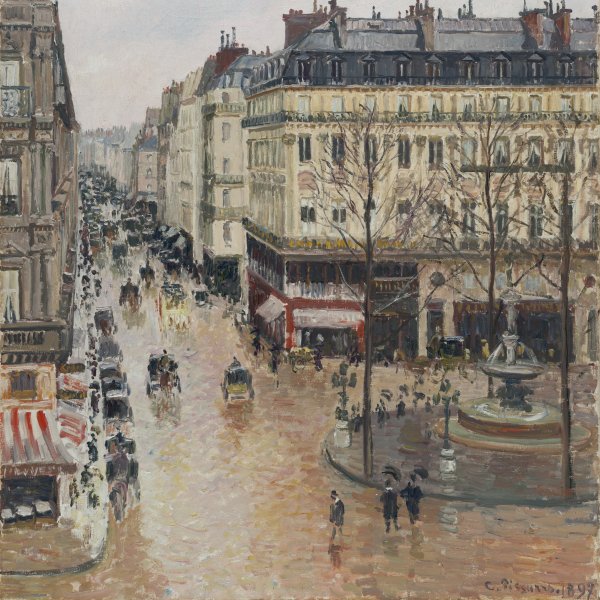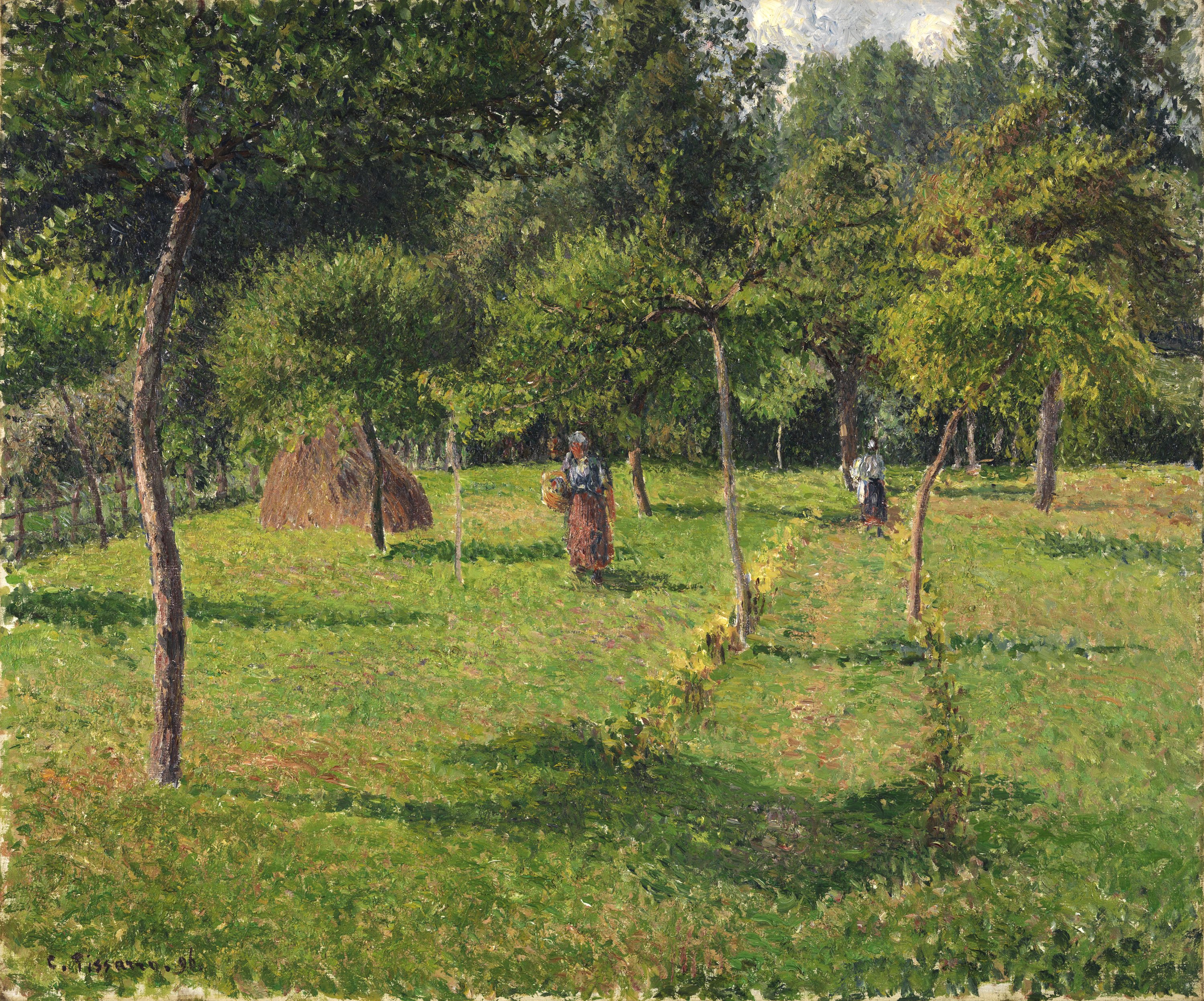The Orchard at Éragny
1896
Oil on canvas.
54.6 x 65.4 cm
Carmen Thyssen Collection
Inv. no. (
CTB.1993.9
)
Room D
Level 0
Carmen Thyssen Collection and Temporary exhibition rooms
Pissarro wrote to his son Lucien on 7 August 1896, saying that he had completed four paintings of the pasture owned by the family near the village of Éragny. He had enjoyed the challenge of painting landscapes dominated by greens throughout his career. In fact, even his earliest paintings had been called "green" by not less a painter than Camille Corot, who claimed that, while he, the older artist, preferred to see nature in tones of grey and blond, Pissarro saw in green!.
This tendency received a renewed impetus in the late 1880s when Pissarro worked very much as a "Scientific" Impressionist with George Seurat and Paul Signac as well as his own son, Lucien, to represent the effect of brilliant sunlight on green grass. Pissarro made the space and character of the sun-struck green field in Éragny interesting by positioning himself so that the varyingly curved trunks of the fruit trees within it played rhythmic visual games with the shadows cast by the trees on the field. This "chess set" of positions is animated by Pissarro's careful placement of two rural workers, a female carrying a basket in the middle-ground and another, further back who seems to have some laundry over her shoulder. We feel the heat of this Norman day as the individually painted leaves of near and distant trees seem to tremble in a gentle breeze.
Pissarro had tired of the meticulously rendered "dotted" surfaces of Scientific Impressionism at least years before, loosening his facture, while adhering to the chromatic lessons of simultaneous contrast and chromatic intensity he practised with more theoretical acumen in the latter 1880s. The Carmen Thyssen-Bornemisza painting seems almost to be a pair of another of the four canvases, Soleil Couchant a Éragny, 1896, PV 974, which is of identical dimensions and represent precisely the same field with the same haystack observed from a different vantage point at a different time. In fact, the group of four paintings were made throughout several similar summer days, one begun in the morning (La Grange, matin, Éragny, c. 1896, PV 975), two at mid-day (Le Clos a Éragny, 1896, and Sous le noyer a Éragny, 1896, PV 976) and the fourth at sunset (Soleil Couchant a Éragny, 1896, PV 974). Pissarro complained of the uncertain weather in the same letter, using it as an explanation for the fact that he ventured only slightly outside the compound of his house and studio into the adjacent field.
Interestingly, this small group of forthrightly rural paintings, made just after the hay harvest in late July and early August, was bracketed in Pissarro's production of that year by two groups of forthrightly urban paintings made in the capital of Normandy, the nearby city of Rouen. This series, made in the spring-early-summer and the fall of 1896, included at least 28 paintings of effects of diurnal and seasonal light on the Seine river and its citified borders. Many of these paintings are dominated by variously coloured "greys, " and it must have been a liberation for Pissarro to dive into the brilliant greens and yellows of his palette to create resolutely summery paintings that are both a chromatic and iconographical counterpoint to the urban series. In fact, Pissarro had painted more than thirty canvases of this same field in the previous decade in every season and format, using vertically and horizontally oriented canvases, to form an intimate series of what we might call personal landscapes.
Richard R. Brettell
This tendency received a renewed impetus in the late 1880s when Pissarro worked very much as a "Scientific" Impressionist with George Seurat and Paul Signac as well as his own son, Lucien, to represent the effect of brilliant sunlight on green grass. Pissarro made the space and character of the sun-struck green field in Éragny interesting by positioning himself so that the varyingly curved trunks of the fruit trees within it played rhythmic visual games with the shadows cast by the trees on the field. This "chess set" of positions is animated by Pissarro's careful placement of two rural workers, a female carrying a basket in the middle-ground and another, further back who seems to have some laundry over her shoulder. We feel the heat of this Norman day as the individually painted leaves of near and distant trees seem to tremble in a gentle breeze.
Pissarro had tired of the meticulously rendered "dotted" surfaces of Scientific Impressionism at least years before, loosening his facture, while adhering to the chromatic lessons of simultaneous contrast and chromatic intensity he practised with more theoretical acumen in the latter 1880s. The Carmen Thyssen-Bornemisza painting seems almost to be a pair of another of the four canvases, Soleil Couchant a Éragny, 1896, PV 974, which is of identical dimensions and represent precisely the same field with the same haystack observed from a different vantage point at a different time. In fact, the group of four paintings were made throughout several similar summer days, one begun in the morning (La Grange, matin, Éragny, c. 1896, PV 975), two at mid-day (Le Clos a Éragny, 1896, and Sous le noyer a Éragny, 1896, PV 976) and the fourth at sunset (Soleil Couchant a Éragny, 1896, PV 974). Pissarro complained of the uncertain weather in the same letter, using it as an explanation for the fact that he ventured only slightly outside the compound of his house and studio into the adjacent field.
Interestingly, this small group of forthrightly rural paintings, made just after the hay harvest in late July and early August, was bracketed in Pissarro's production of that year by two groups of forthrightly urban paintings made in the capital of Normandy, the nearby city of Rouen. This series, made in the spring-early-summer and the fall of 1896, included at least 28 paintings of effects of diurnal and seasonal light on the Seine river and its citified borders. Many of these paintings are dominated by variously coloured "greys, " and it must have been a liberation for Pissarro to dive into the brilliant greens and yellows of his palette to create resolutely summery paintings that are both a chromatic and iconographical counterpoint to the urban series. In fact, Pissarro had painted more than thirty canvases of this same field in the previous decade in every season and format, using vertically and horizontally oriented canvases, to form an intimate series of what we might call personal landscapes.
Richard R. Brettell





